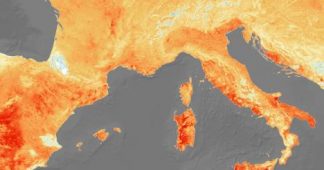By George Dvorsky
New research shows that temperatures are set to skyrocket in parts of the Middle East and Africa, making human habitation next to impossible. In a region that’s home to 500 million people, that could trigger a climate-exodus of epic proportions.
These new climate projections, compiled by researchers from the Max Planck Institute, tell an incredibly scary story—like, apocalyptic Mad Max scary. According to Johannes Lelieveld and colleagues, even if Earth’s average temperature were to increase by two degrees Celsius compared to pre-industrial times, the summer temperature in these regions would still increase more than twofold by the midpoint of the century. Combined with prolonged heat waves, decades-long megadroughts, and windblown desert dust, these environmental conditions would be intolerable for humans, forcing many to migrate.
By 2050, summer temperatures in parts of the Middle East and North Africa would stay above 86ºF (30ºC) at night. During the day, temperatures during the hot seasons are predicted to rise to 114ºF (46ºC). By the end of the century, midday temperatures would reach 122ºF (50ºC). By comparison, the average maximum summer temperature in Eastern California’s Death Valley is 115ºF (46ºC).
Heat waves will likely occur ten times more frequently than they do now, and they’ll last much longer. Prior to 2005, there were about 16 excruciatingly hot days per year on average. According to the new models, it will be unusually hot for about 80 days per year—a figure that will jump to 118 days by the end of the century.
And if all this wasn’t bad enough, the researchers also found that desert dust in the atmosphere is increasing over Saudi Arabia, Iraq, and Syria. They’re attributing this to an increase of sand storms as a result of protracted droughts. Climate change will exacerbate this even further.
Needless to say, this will have a dramatic effect on people who live in these areas.
“Climate change will significantly worsen the living conditions in the Middle East and in North Africa,” noted Lelieveld in a statement. “Prolonged heat waves and desert dust storms can render some regions uninhabitable, which will surely contribute to the pressure to migrate.”
For the study, the researchers based their calculations on two scenarios, one in which global emissions of greenhouse gases start decreasing by 2040 (i.e. we succeed at meeting the climate target set at the recent UN Climate Summit in Paris), the other based on the assumption that greenhouse gases will continue to increase unabated (usually referred to as the “business-as-usual scenario.”). In the latter scenario, the mean surface temperature of our planet will increase by more than 4ºC compared to pre-industrial times.
Unfortunately, both scenarios yielded dramatic temperature rises in these desert regions, particularly during the summer months when it’s already very hot. Parched desert surfaces cannot cool by the evaporation of groundwater, and since the balance of surface energy is controlled by heat radiation, this makes the greenhouse gas effect even worse.











